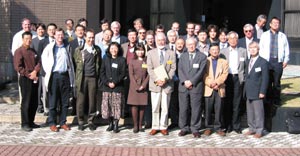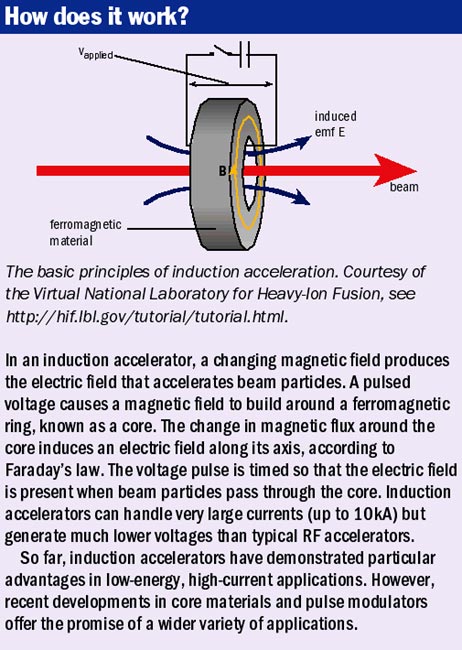It was a milestone event in the history of induction accelerators when more than 55 experts assembled at KEK in October 2002 for an international workshop on Recent Progress in Induction Accelerators – RPIA2002.

They came from 15 different institutes and three private companies. Their purpose: to discuss recent progress in induction accelerators and the key technologies that are common to the different communities of heavy-ion inertial fusion and high-energy accelerators. The workshop focused on four topics:
• A review of developments in induction acceleration since the first demonstration by Nicholas Christofilos, applications, and up-to-date activities in energy research and high-energy physics.
• New concepts and ideas using induction acceleration.
• Key technologies, such as magnetic materials and solid-state modulators, which are indispensable for the realization of high-gradient accelerating fields and low-loss, high rep-rate operation.
• Beam dynamics specific to extremely high-intensity beam linacs, circular induction accelerators and hadron colliders employing a so-called super-bunch.
In his welcome address, Hirotaka Sugawara, director-general of KEK, stressed the importance of investment in accelerator R&D when he talked of the recent activities of ICFA as well as the status of ongoing and future projects at KEK.
The review of the history of induction accelerators ranged from the late 1960s with the first machine, ASTRON, to the recent Advanced Test Accelerator and Experimental Test Accelerator at the Lawrence Livermore National Laboratory (LLNL). A large variety of applications were also reviewed, from early applications to electron ring acceleration and high-power microwave generation. More recently, electron induction linacs have successfully demonstrated their capability as high-intensity electron beam drivers for free-electron lasers (at LLNL, KEK, the Japan Atomic Energy Research Institute (JAERI) and CESTA in France), as a relativistic klystron at LLNL/LBNL, and as a backward wave oscillator at JAERI.
The Virtual National Laboratory (VNL) in the US has recently focused on R&D work for a heavy-ion inertial fusion driver, using 4 GeV bismuth beams, with a 2 kA/beam and a 10 ns pulse length. The workshop heard about the US Heavy Ion Fusion Accelerator Program, which is concentrating on three areas: source/injector development, low energy transport, and neutralization in ballistic focusing. The goals and key issues of an Integrated Beam Experiment, which is planned to verify the concept, were also discussed. A complementary simulation study at Tokyo Institute of Technology has shown that halo formation during the last bunch-compression stage is a big concern. Details of the solid-state power modulator (1 MHz burst frequency), developed for precise waveform control in this programme, were presented at the workshop and extensive results from measurements on the magnetic properties of possible core materials were reported. The latter will serve as a database for future applications.
In X-ray radiography the DARHT-2 accelerator (20 MeV, 2 kA, 2 µs duration) at LLNL has succeeded the earlier generation of electron induction linacs. A novel technology for a high-frequency induction kicker system was reported and the importance of beam-plasma interactions near an X-ray target was discussed – both topics are of particular importance in X-ray radiography.
Moving on from linear machines, the concept of an induction synchrotron – a circular induction accelerator proposed by Ken Takayama and Junichi Kishiro in 1999 – was discussed. By using super-bunches, such a machine is capable of accelerating a beam of two to four times higher intensity than in a conventional RF synchrotron. An outline of the POP experiment in the KEK 12 GeV PS was given. In addition, the current status of R&D work on the 1 MHz rep-rate modulator and 2.5 kV/unit accelerating cavity for the POP experiment were reported.

The concept of a super-bunch hadron collider is regarded as a natural extension to the concept of an induction synchrotron and is expected to provide a luminosity 10 times higher. A typical example was reviewed and specific beam physics issues, such as parasitic beam-beam effects in the super-bunch collisions and the head-tail instability of a super-bunch, were discussed. A super-bunch option for the LHC upgrade plans triggered some interesting arguments at the workshop, where the figure of merit for employing a super-bunch was extensively discussed. Regarding barrier bucket beam handling, which should play a crucial role in super-bunch acceleration, an experimental result using an RF barrier bucket in the Fermilab Recycler Ring and a novel stacking technique were reported.
Four hot topics in current high-energy physics experiments were presented at the workshop: Tevatron Run II, K2K, MiniBoone and NuMI/MINOS, and the LHC. It was stated that most current hadron collider detector components could not survive a 10-fold increase in luminosity, so the possibility of such high luminosity is now challenging experimentalists. In the meantime, an increase of a factor of three to four in beam intensity should have a big impact on future neutrino oscillation experiments.
Details of a newly developed magnetic material, FINEMET, which is regarded as one of the core materials suitable for an induction accelerating device, were reported by the manufacturer, who pointed out its relatively large swing width, low core-loss, high Curie temperature and small dependence of µQf on flux density. Various applications using FINEMET include an induction cavity, a high-gradient and low-Q RF cavity (magnetic alloy loaded cavity), and an accelerating device for a beam chopper. The characteristics and basic performance of the semi-conducting switching elements of the MOSFET and the Static Induction (SI) Thyristor were also reviewed, together with the capability and future of the SiC-MOSFET, which is under development and promises a high breakdown voltage and lower on-resistance. It was reported that a solid-state power modulator is reliable in many applications, including a fast kicker pulser for an electron induction accelerator (MOSFET, ±18 kV, 10 ns rise/fall times, 16-200 ns pulse widths, multi-pulse burst) or for proton/electron ring accelerators (50 kV, 5 MHz burst, 73 ns flat-top), and a klystron modulator for the Next Linear Collider (IGBT, 500 kV, 3 µs, 120 Hz), KEKB injector (SI Thyristor, 45 kV, 6 µs, 50 Hz) or the Japan Linear Collider (IGBT, 500 kV, 1.6 µs, 150 Hz).
Overall the discussions on modern induction accelerators revealed two distinct trends: high-gradient and low rep-rate induction acceleration, and low-gradient and high rep-rate induction acceleration. The former is used in heavy-ion inertial fusion drivers, while the latter should be indispensable in a circular machine such as an induction synchrotron or super-bunch hadron collider. Because devices independently developed in the two different communities are based on common technologies, the mutual exchange of information will become more and more important if each community is to realize its dreams.
Further reading
Details of the workshop are at http://conference.kek.jp/RPIA2002.





